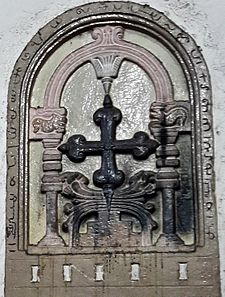Yaqob of India
|
Mar Yaqob of India(AD 1301) |
|
|---|---|
 |
|
| Diocese | kodungallur |
| Installed | ? |
| Term ended | 1330 |
| Successor | Mar Yohannan(1490-1503) |
| Orders | |
| Ordination | by Yahballaha III (1245–1317) |
| Personal details | |
| Died | unknown Cranganore? |
| Buried | ? |
Mar Yaqob of India, also known as Mar Jacob, was a metropolitan bishop of the St Thomas Christians of Malabar. The history and legends of the east Syrian prelates in India prior to the arrival of European explorers are shrouded in mystery because of the unavailability of surviving documents. The Vatican Syrian codex 22, the oldest surviving Syrian manuscript written in Malabar, specifically mentions an east Syrian bishop who was residing in Malabar at that time. According to this ancient document, (now in the Vatican Library), which was written by a Deacon named Zachariah bar Joseph addresss Mar Jacob as Metropolitan and director of the holy see of the Apostle St Thomas, the great captain and the director of the entire holy church of India.
The Christians of St. Thomas became strong enough to achieve independence. Before the coming of the Portuguese,St. Thomas installed Christian rulers of their own (Villarvattom) to be absorbed into the rajahs of Cochin. The metropolitan of Angamali was assisted in the operations of his office by an archdeacon. The archdeacon was selected by the Catholics from the influential Pakalomattom family. Upon the death of the metropolitan, the archdeacon was left with the task of managing the office alone. He petitioned the patriarch to name a successor to the deceased metropolitan.
Painting a comprehensive picture of this time in Ancient Indian Christianity remains an insurmountable task. The source material for this dark period, which existed in the East Syrian repositories of Mesopotamia and in the old records of the Indian churches, was destroyed by the Mongol hordes on the one side and by the Portuguese on the other. In fact, the vandalism of the Mongol invasions of the Middle East was only surpassed in this sphere by the repercussions of the Synod of Diamper in 1599. That act of faith simply led to the obliteration of all Indian records, since it was decided to burn all religious manuscripts tainted with the heresy of Nestorius. Thus historic records of The Malabar Church became lost to time. Cardinal Tisserant, however, registers a few minor references bearing upon the later medieval history of that church. The first dates from the fourteenth century, when a copyist named Zaccharias bar joseph bar Zaccharias made an allusion to the Catholicos Yahballaha III (1245–1314) and to Mar Jacob, bishop of India, in 1301.
...
Wikipedia
